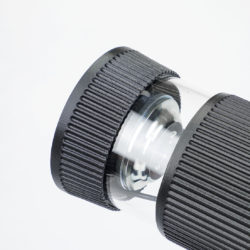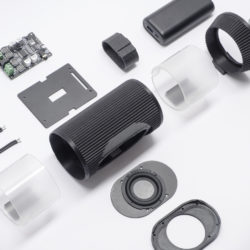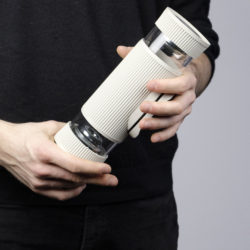Open System Speaker
Description
A concept for a sustainable Bluetooth speaker. Construction, production, and sale of the speaker are designed in an open system. Electronic components from various manufacturers can be exchanged, integrated and updated at will. Manufacturers upload their components on an online platform, which are then integrated into the System through a parametrically generated 3-D print connector. The customer can customize his device via the platform. The connecting elements are produced on-demand by the consumer himself/herself or by local suppliers. The complete assembly and disassembly takes only a few minutes. Each component can be updated over time. The repair is not bound to specific spare parts. The platform is intended to connect manufacturers and customers, whether for product purchase, spare parts, or information exchange. The maintenance costs of the platform will be charged transparently pro-rata.What is the Topic?
The production of consumer electronics requires an enormous amount of resources and energy. Nevertheless, most devices are only used for a very short time. They are difficult to disassemble and therefore hardly repairable. Spare parts are relatively expensive or not available. The environmental problems of electronic goods are additionally aggravated by low recycling rates of less than 50 %. The design of the Open System Speaker aims at minimizing possible obsolescence to enable a long sustainable use. All parts are accessible and easy to dismantle. Harmful toxic components, such as the battery, can be disposed of properly. The repair is not bound to specific spare parts. The device can be updated over time by integrating new components. The core of the concept is to achieve transparency and accessibility. It enables repairing without technical knowledge. The online platform is an unbiased basis for networking and mutual support among consumers. Second-hand components can be traded among each other via the platform. Someone from the community can be found locally to print a spare part. These structures make repairing easy and independent. They enable responsible consumption and the sharing of know-how and resources.
Why does it look like this?
The speaker is designed for a good sound volume while keeping the housing as compact as possible. The system limit for the domes is therefore designed for 1.5" to 3". For easy mounting, most of the speaker's connections can be detached without tools. The cylindrical shape corresponding to the drivers is divided by four bayonet joints. The transparent tube connectors, make the accessibility of the components clear. The slight riffling of the surface allows the speaker to be gripped securely and the bayonet joint to be operated more easily. The stand also acts as a lock for the bass membrane.
What is special?
Special about the concept is the decentralized on-demand production, which is coordinated via an online platform. This platform is also used for the exchange of spare parts, used parts, and information. The platform is not designed for growth or profit.
What is new?
The design of the product in an open system, in which components can be integrated within certain system boundaries. Therefore the product can be adapted and modified.




